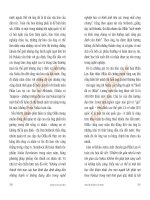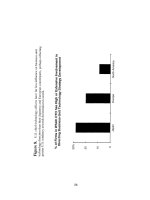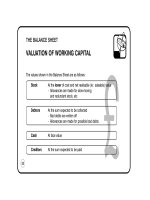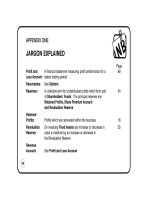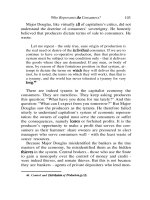the bastiat collection volume 1 phần 1 ppt
Bạn đang xem bản rút gọn của tài liệu. Xem và tải ngay bản đầy đủ của tài liệu tại đây (595.9 KB, 47 trang )
T
HE BASTIAT
COLLECTION
2 VOLUMES
Front matter.qxd 7/6/2007 10:58 AM Page i
Front matter.qxd 7/6/2007 10:58 AM Page ii
T
HE BASTIAT
COLLECTION
2 VOLUMES
FRÉDÉRIC BASTIAT
Ludwig
von Mises
Institute
AUBURN, ALABAMA
Front matter.qxd 7/6/2007 10:58 AM Page iii
Copyright © 2007 by the Ludwig von Mises Institute
All rights reserved. No part of this book may be reproduced in any
manner whatsoever without written permission except in the case of
quotes in the context of reviews. For information write the Ludwig
von Mises Institute, 518 West Magnolia Avenue, Auburn, Alabama
36832, U.S.A. www.mises.org.
ISBN: 978-1-933550-07-7
Front matter.qxd 7/6/2007 10:58 AM Page iv
The Ludwig von Mises Institute dedicates this volume
to all of its generous donors, and in particular
wishes to thank these Patrons:
Legatum Global Development
Douglas E. French and Deanna Forbush
Robert L. Luddy
Mr. and Mrs. Jeremy S. Davis
In memory of Mr. and Mrs. Harry G. Guthmann
Don Printz, M.D.
Hall McAdams
Front matter.qxd 7/6/2007 10:58 AM Page v
Front matter.qxd 7/6/2007 10:58 AM Page vi
CONTENTS
VOLUME I
Introduction by Mark Thornton . . . . . . . . . . . . . . . . . . . . .xi
I. That Which Is Seen, and That Which Is Not Seen
. . . . . . .1
1. The Broken Window . . . . . . . . . . . . . . . . . . . . . . . . . . . . . .2
2. The Disbanding of Troops . . . . . . . . . . . . . . . . . . . . . . . . . .5
3. Taxes . . . . . . . . . . . . . . . . . . . . . . . . . . . . . . . . . . . . . . . . . .7
4. Theaters and Fine Arts . . . . . . . . . . . . . . . . . . . . . . . . . . . .11
5. Public Works . . . . . . . . . . . . . . . . . . . . . . . . . . . . . . . . . . .16
6. The Intermediaries . . . . . . . . . . . . . . . . . . . . . . . . . . . . . . .18
7. Protectionism . . . . . . . . . . . . . . . . . . . . . . . . . . . . . . . . . . .24
8. Machinery . . . . . . . . . . . . . . . . . . . . . . . . . . . . . . . . . . . . .29
9. Credit . . . . . . . . . . . . . . . . . . . . . . . . . . . . . . . . . . . . . . . . .34
10. Algeria . . . . . . . . . . . . . . . . . . . . . . . . . . . . . . . . . . . . . . . .37
11. Frugality and Luxury . . . . . . . . . . . . . . . . . . . . . . . . . . . . .41
12. He Who Has a Right to Work Has a Right to Profit . . . . .46
II. The Law . . . . . . . . . . . . . . . . . . . . . . . . . . . . . . . . . . . . . . . .49
III. Government . . . . . . . . . . . . . . . . . . . . . . . . . . . . . . . . . . . . .95
IV. What Is Money? . . . . . . . . . . . . . . . . . . . . . . . . . . . . . . . .109
v
Front matter.qxd 7/6/2007 10:58 AM Page v
vi The Bastiat Collection
V. Capital and Interest . . . . . . . . . . . . . . . . . . . . . . . . . . . . . .135
1. Introduction . . . . . . . . . . . . . . . . . . . . . . . . . . . . . . . . . .135
2. Ought Capital to Produce Interest? . . . . . . . . . . . . . . . . .138
3. What Is Capital? . . . . . . . . . . . . . . . . . . . . . . . . . . . . . . .147
4. The Sack of Corn . . . . . . . . . . . . . . . . . . . . . . . . . . . . . .147
5. The House . . . . . . . . . . . . . . . . . . . . . . . . . . . . . . . . . . . .150
6. The Plane . . . . . . . . . . . . . . . . . . . . . . . . . . . . . . . . . . . . .151
7. What Regulates Interest? . . . . . . . . . . . . . . . . . . . . . . . . .162
VI. Economic Sophisms—First Series . . . . . . . . . . . . . . . . . .169
Introduction . . . . . . . . . . . . . . . . . . . . . . . . . . . . . . . . . .171
1. Abundance—Scarcity . . . . . . . . . . . . . . . . . . . . . . . . . . . . 175
2. Obstacle—Cause . . . . . . . . . . . . . . . . . . . . . . . . . . . . . . .185
3. Effort—Result . . . . . . . . . . . . . . . . . . . . . . . . . . . . . . . . .189
4. To Equalize the Conditions of Production . . . . . . . . . . . .197
5. Our Products Are Burdened with Taxes . . . . . . . . . . . . . .215
6. Balance of Trade . . . . . . . . . . . . . . . . . . . . . . . . . . . . . . . .221
7. Petition of the Manufacturers of Candles, Waxlights,
Lamps, Candlelights, Street Lamps, Snuffers,
Extinguishers, and the Producers of Oil, Tallow, Resin,
Alcohol, and, Generally, of Everything Connected
with Lighting . . . . . . . . . . . . . . . . . . . . . . . . . . . . . . . . . .227
8. Differential Duties—Tariffs . . . . . . . . . . . . . . . . . . . . . . .233
9. Immense Discovery . . . . . . . . . . . . . . . . . . . . . . . . . . . . .235
10. Reciprocity . . . . . . . . . . . . . . . . . . . . . . . . . . . . . . . . . . . .239
11. Nominal Prices . . . . . . . . . . . . . . . . . . . . . . . . . . . . . . . . .243
12. Does Protection Raise Wages? . . . . . . . . . . . . . . . . . . . . .247
13. Theory—Practice . . . . . . . . . . . . . . . . . . . . . . . . . . . . . . .251
14. Conflict of Principles . . . . . . . . . . . . . . . . . . . . . . . . . . . .259
15. Reciprocity Again . . . . . . . . . . . . . . . . . . . . . . . . . . . . . . .263
16. Obstruction—The Plea of the Protectionist . . . . . . . . . . . .267
17. A Negative Railway . . . . . . . . . . . . . . . . . . . . . . . . . . . . .269
Front matter.qxd 7/6/2007 10:58 AM Page vi
18. There Are No Absolute Principles . . . . . . . . . . . . . . . . . .271
19. National Independence . . . . . . . . . . . . . . . . . . . . . . . . . . .275
20. Human Labor—National Labor . . . . . . . . . . . . . . . . . . . .279
21. Raw Materials . . . . . . . . . . . . . . . . . . . . . . . . . . . . . . . . .285
22. Metaphors . . . . . . . . . . . . . . . . . . . . . . . . . . . . . . . . . . . .295
23. Conclusion . . . . . . . . . . . . . . . . . . . . . . . . . . . . . . . . . . . .299
VII. Economic Sophisms—Second Series . . . . . . . . . . . . . . .305
1. Natural History of Spoliation . . . . . . . . . . . . . . . . . . . . . .307
2. Two Systems of Morals . . . . . . . . . . . . . . . . . . . . . . . . . .325
3. The Two Hatchets . . . . . . . . . . . . . . . . . . . . . . . . . . . . . .333
4. Lower Council of Labor . . . . . . . . . . . . . . . . . . . . . . . . . .337
5. Dearness—Cheapness . . . . . . . . . . . . . . . . . . . . . . . . . . . .341
6. To Artisans and Workmen . . . . . . . . . . . . . . . . . . . . . . . .351
7. A Chinese Story . . . . . . . . . . . . . . . . . . . . . . . . . . . . . . . .361
8. Post Hoc, Ergo Propter Hoc . . . . . . . . . . . . . . . . . . . . . .367
9. The Premium Theft—Robbery by Subsidy . . . . . . . . . . . .371
10. The Tax Gatherer . . . . . . . . . . . . . . . . . . . . . . . . . . . . . . .381
11. Protection; or, The Three City Aldermen . . . . . . . . . . . . .387
12. Something Else . . . . . . . . . . . . . . . . . . . . . . . . . . . . . . . . .399
13. The Little Arsenal of the Free-Trader . . . . . . . . . . . . . . . .409
14. The Right Hand and the Left . . . . . . . . . . . . . . . . . . . . . .417
15. Domination by Labor . . . . . . . . . . . . . . . . . . . . . . . . . . . .425
Index . . . . . . . . . . . . . . . . . . . . . . . . . . . . . . . . . . . . . . . . . . . . . .431
Contents vii
Front matter.qxd 7/6/2007 10:58 AM Page vii
Front matter.qxd 7/6/2007 10:58 AM Page viii
I
NTRODUCTION
And now I would appeal with confidence to men of all
schools, who prefer truth, justice, and the public good to
their own systems. Economists! Like you, I am the advocate
of LIBERTY; and if I succeed in shaking some of these prem-
ises which sadden your generous hearts, perhaps you will
see in this an additional incentive to love and to serve our
sacred cause.
Bastiat, “To the Youth of France,”
Economic Harmonies, p. 14
C
laude Frédéric Bastiat was born in Bayonne, France on
June 29th, 1801. He was orphaned at age 9 and raised by
relatives. He worked in his uncle’s accounting firm and
then became a farmer when he inherited his grandfather’s farm.
After the middle-class Revolution of 1830, Bastiat became politi-
cally active and was elected Justice of the Peace in 1831 and to
the Council General (county-level assembly) in 1832. He was
elected to the national legislative assembly after the French Rev-
olution of 1848. Bastiat was inspired by and routinely corre-
sponded with Richard Cobden and the English Anti-Corn Law
League and worked with free-trade associations in France. Bastiat
wrote sporadically starting in the 1830s, but in 1844 he launched
ix
Intro to collection.qxd 7/6/2007 10:58 AM Page ix
his amazing publishing career when an article on the effects of
protectionism on the French and English people was published in
the Journal des Economistes which was held to critical acclaim.
1
The bulk of his remarkable writing career that so inspired the
early generation of English translators—and so many more—is
contained in this collection.
If we were to take the greatest economists from all ages and
judge them on the basis of their theoretical rigor, their influence
on economic education, and their impact in support of the free-
market economy, then Frédéric Bastiat would be at the top of the
list. As Murray N. Rothbard noted:
Bastiat was indeed a lucid and superb writer, whose brilliant
and witty essays and fables to this day are remarkable and
devastating demolitions of protectionism and of all forms of
government subsidy and control. He was a truly scintillating
advocate of an untrammeled free market.
2
This book brings together his greatest works and represents
the early generation of English translations. These translators
were like Bastiat himself, people from the private sector who had
a love of knowledge and truth and who altered their careers to
vigorously pursue intellectual ventures, scholarly publishing, and
advocacy of free trade.
This collection represents some of the best economics ever
written. He was the first, and one of the very few, to be able to
convincingly communicate the basic propositions of economics.
The vast majority of people who have learned anything about eco-
nomics have relied on Bastiat or publications that were influenced
x The Bastiat Collection
1
For biographical material on Bastiat see George Roche’s Frédéric Bas-
tiat: A Man Alone (New Rochelle, N.Y.: Arlington House, 1971) and Dean
Russell’s Frédéric Bastiat: Ideas and Influences (Irvington-on-Hudson, N.Y.:
Foundation for Economic Education, 1969).
2
Murray N. Rothbard, Classical Economics: An Austrian Perspective on
the History of Economic Thought, vol. II (1995; Auburn, Ala.: Ludwig von
Mises Institute, 2006), p. 444.
Intro to collection.qxd 7/6/2007 10:58 AM Page x
by his work. This collection—possibly more than anything ever
written about economics—is the antidote for economic illiteracy
regarding such things as the inadvisability of tariffs and price con-
trols, and everyone from the novice to the Ph.D. economist will
benefit from reading it.
The collection consists of three sections, the first of which
contains his best-known essays. In “That Which is Seen, and That
Which is Not Seen,” Bastiat equips the reader to become an econ-
omist in the first paragraph and then presents the story of the bro-
ken window where a hoodlum is thought to create jobs and pros-
perity by breaking windows. Bastiat solves the quandary of
prosperity via destruction by noting that while the apparent pros-
perity is seen, what is unseen is that which would have been pro-
duced had the windows not been broken. According to Rothbard:
In this way, the “economist,” Bastiat’s third-level observer,
vindicates common sense and refutes the apologia for
destruction of the pseudo-sophisticate. He considers what is
not seen as well as what is seen. Bastiat, the economist, is
the truly sophisticated analyst.
3
Professor Jörg Guido Hülsmann credits Bastiat for discover-
ing this counterfactual method, which allowed Bastiat to show
that destruction (and a variety of government policies) is actually
the path to poverty, not prosperity. This lesson is then applied to
a variety of more complex cases and readers will never be able to
deny that scarcity exists and will always—hopefully—remember
that every policy has an opportunity cost. If nothing else, they will
not believe—as is often claimed—that earthquakes, hurricanes,
and wars lead to prosperity. The remaining essays cover the impor-
tant institutions of society—law, government, money, and capi-
tal—where Bastiat explains the nature of these institutions and
Introduction xi
3
Ibid., p. 445.
Intro to collection.qxd 7/6/2007 10:58 AM Page xi
disabuses the reader of all the common misconceptions regarding
them.
The second section is Bastiat’s Economic Sophisms, a collec-
tion of 35 articles on the errors of protectionism broadly con-
ceived. Here Bastiat shows his mastery of the methods of argu-
mentation—using basic logic and taking arguments to their logical
extreme—to demonstrate and ridicule them as obvious fallacies. In
his “Negative Railroad” Bastiat argues that if an artificial break in
a railroad causes prosperity by creating jobs for boatmen, porters,
and hotel owners, then there should be not one break, but many,
and indeed the railroad should be just a series of breaks—a nega-
tive railroad. In his article “An Immense Discovery!” he asks,
would it not be easier and faster simply to lower the tariff
between points A and B rather than building a new railroad to
transport products at a lower cost? His “Petition of the Candle-
makers” argues in jest that a law should be passed to require that
all doors and windows be closed and covered during the day to
prevent the sun from unfairly competing with the makers of can-
dles and that if such a law were passed it would create high-pay-
ing jobs in candle and candlestick making, oil lamps, whale oil,
etc. and that practically everyone would profit as a result.
The third section is Bastiat’s Economic Harmonies which was
hastily written before his death in 1850 and is considered incom-
plete. Here he demonstrates that the interests of everyone in soci-
ety are in harmony to the extent that property rights are
respected. Because there are no inherent conflicts in the market,
government intervention is unnecessary. The borrower wants
lenders to thrive so that loans will be available and the lender
wants borrowers to thrive in order to collect interest on savings
and to be paid back the loan principal. This book is the basis of
charges that critics have levied against Bastiat, claiming that he
made theoretical errors and failed to extend the corpus of theory.
I have shown elsewhere that these criticisms must represent a mis-
reading of Bastiat, and Rothbard showed that Bastiat made the
vital contribution of returning economics to a focus on wants,
xii The Bastiat Collection
Intro to collection.qxd 7/6/2007 10:58 AM Page xii
exchange, and consumption correcting the errors of British polit-
ical economy.
4
In a more recent and very important reappraisal of Bastiat,
Professor Hülsmann has shown my suspicions to be correct.
5
He
demonstrates that Bastiat’s Harmonies is an important theoretical
innovation that was widely dismissed by interventionists and
attacked by equilibrium theorists. Interventionists dismissed it
because the analysis proves that society can thrive without any
government intervention in the economy. Equilibrium theorists
saw Bastiat’s conception of harmony as competition for their own
concept of equilibrium—and rightly so—because while equilib-
rium is at best a useful fiction, harmony is an accurate conception
of what actually exists in a free-market world. Therefore, the
equilibrium approach can in some cases mimic or equal harmony,
but it can also be applied to misleading ends and is inapplicable
for others. Hülsmann also brilliantly shows how critics have mis-
read and therefore misunderstood Bastiat’s concept of value and
service and that their criticisms are invalid. The Hülsmann reap-
praisal smashes the critics and their echoes and is therefore an
important primer for this section. Also see the important article
by Joseph T. Salerno who shows that the marginalization of Bas-
tiat and the French school involved a long process of deliberate
distortion by their doctrinal enemies among the Anglo-American
economists.
6
Patrick James Stirling translated Bastiat’s Economic Har-
monies (1860) and Economic Sophisms (1863) which are repro-
duced in this collection. Stirling was a student of Thomas
Chalmers, an important Scottish economist of the first half of the
Introduction xiii
4
Mark Thornton, “Frédéric Bastiat was an Austrian Economist,” Jour-
nal des Economistes et des Etudes Humaines 11, no. 2/3 (June/September
2001): 387–98.
5
Jörg Guido Hülsmann, “Bastiat’s Legacy in Economics,” Quarterly
Journal of Austrian Economics 4, no. 4 (Winter 2000) pp. 55–70.
6
Joseph T. Salerno, “The Neglect of Bastiat’s School by English-Speak-
ing Economists: A Puzzle Resolved,” Journal des Économistes et des Etudes
Humaines 11, no. 2/3 (June/September 2001), pp. 451–95.
Intro to collection.qxd 7/6/2007 10:58 AM Page xiii
nineteenth century and leader of the Free Kirk schism from the
Church of Scotland. Stirling was the author of The Philosophy of
Trade, in which he provided a theory of prices and profits and
examined the principles that determine the relative value of
goods, labor, and money.
7
In The Australian and Californian Gold
Discoveries and their Probable Consequences he examined the
impact of the large nineteenth-century gold discoveries and the
laws that determined the value and distribution of money and
where he exhibited a proto-Austrian theory of the business cycle.
8
Stirling has recently resurfaced in the economics literature as the
author of the oldest known undergraduate essay in economics.
9
We remain uncertain regarding the early translations of the essays
in the first section of this volume (many translations of this period
were unsigned), but what we do know seems to reinforce the
Scottish connection to Bastiat. William Ballantyne Hodgson, who
held a Chair in Political Economy at the University of Edinburgh,
translated the essays from “Things Seen and Things Not Seen” for
publication in newspapers and were later published as a booklet
10
and Economic Sophisms was first translated by Mrs. Louisa
McCord (a Scottish surname) from Charleston, South Carolina.
11
xiv The Bastiat Collection
7
Patrick James Stirling, The Philosophy of Trade (Edinburgh: Oliver &
Boyd, 1846); or outlines of a theory of profits and prices, including an
examination of the principles which determine the relative value of corn,
labor, and currency.
8
The Australian and Californian Gold Discoveries and Their Probable
Consequences: An Inquiry Into The Laws which Determine the Value and
Distribution of the Precious Metals with Historical Notices of the Effects of
the American Mines on European Prices in the Sixteenth, Seventeenth and
Eighteenth Centuries (Oliver and Boyd, 1853).
9
A.M.C. Waterman, “The Oldest Extant Undergraduate Essay in Eco-
nomics?” Journal of the History of Economic Thought 27, no. 4 (December
2005): 359–73.
10
William Ballantyne Hodgson, “Things Seen and Things Not Seen”
(London: Cassel & Company Limited, 1910), abridged from the translation
by Dr. Hodgson in 1852.
11
Louisa S. McCord, Sophisms of the Protective Policy (New York:
Wiley and Putnam, 1848). McCord wrote widely on economics and politics
Intro to collection.qxd 7/6/2007 10:58 AM Page xiv
Introduction xv
anonymously because her contemporaries would consider it inappropriate
for a woman to be writing on such controversial matters.
12
David A. Wells, Essays on Political Economy (New York: G.P. Put-
nam’s Sons, 1877). Wells was a successful writer, publisher, and inventor.
He opposed the income tax and supported free trade and the gold standard.
He was appointed chairman of the national revenue commission after the
Civil War and is said to have placed the U.S. on a scientific revenue system.
The first section is based on the David Wells (also a Scottish sur-
name) edition of the essays which contained the long out-of-print
essay, “What is Money?”
12
This collection of early translations is dedicated to improving
economic literacy and eliminating the frustration of economic
teachers everywhere. No one is better to do so, and in such a
forceful and entertaining way, than Bastiat. Enjoy.
Mark Thornton
May 2007
Intro to collection.qxd 7/6/2007 10:58 AM Page xv
Intro to collection.qxd 7/6/2007 10:58 AM Page xvi
I.
THAT WHICH IS SEEN,
AND THAT WHICH IS NOT SEEN
1
I
n the economy, an act, a habit, an institution, a law, gives birth
not only to an effect, but to a series of effects. Of these effects,
the first only is immediate; it manifests itself simultaneously
with its cause—it is seen. The others unfold in succession—they
are not seen: it is well for us if they are foreseen. Between a good
and a bad economist this constitutes the whole difference—the
one takes account of the visible effect; the other takes account
both of the effects which are seen and also of those which it is
necessary to foresee. Now this difference is enormous, for it
almost always happens that when the immediate consequence is
favorable, the ultimate consequences are fatal, and the converse.
Hence it follows that the bad economist pursues a small present
good, which will be followed by a great evil to come, while the
true economist pursues a great good to come, at the risk of a small
present evil.
1
1
First published in 1850.
That Which is Seen qxd 7/6/2007 10:58 AM Page 1
In fact, it is the same in the science of health, arts, and in that
of morals. It often happens, that the sweeter the first fruit of a
habit is, the more bitter are the consequences. Take, for example,
debauchery, idleness, prodigality. When, therefore, a man,
absorbed in the effect which is seen, has not yet learned to discern
those which are not seen, he gives way to fatal habits, not only by
inclination, but by calculation.
This explains the fatally grievous condition of mankind. Igno-
rance surrounds its cradle: then its actions are determined by
their first consequences, the only ones which, in its first stage, it
can see. It is only in the long run that it learns to take account of
the others. It has to learn this lesson from two very different mas-
ters—experience and foresight. Experience teaches effectually,
but brutally. It makes us acquainted with all the effects of an
action, by causing us to feel them; and we cannot fail to finish by
knowing that fire burns, if we have burned ourselves. For this
rough teacher, I should like, if possible, to substitute a more gen-
tle one. I mean Foresight. For this purpose I shall examine the
consequences of certain economical phenomena, by placing in
opposition to each other those which are seen, and those which
are not seen.
1. T
HE BROKEN WINDOW
Have you ever witnessed the anger of the good shopkeeper,
John Q. Citizen, when his careless son happened to break a pane
of glass? If you have been present at such a scene, you will most
assuredly bear witness to the fact, that every one of the spectators,
were there even 30 of them, by common consent apparently,
offered the unfortunate owner this invariable consolation: “It is
an ill wind that blows nobody good. Everybody must live, and
what would become of the glaziers if panes of glass were never
broken?”
Now, this form of condolence contains an entire theory,
which it will be well to show up in this simple case, seeing that it
is precisely the same as that which, unhappily, regulates the
2 The Bastiat Collection
That Which is Seen qxd 7/6/2007 10:58 AM Page 2
greater part of our economical institutions. Suppose it cost six
francs to repair the damage, and you say that the accident brings
six francs to the glazier’s trade—that it encourages that trade to
the amount of six francs—I grant it; I have not a word to say
against it; you reason justly. The glazier comes, performs his task,
receives his six francs, rubs his hands, and, in his heart, blesses the
careless child. All this is that which is seen.
But if, on the other hand, you come to the conclusion, as is
too often the case, that it is a good thing to break windows, that
it causes money to circulate, and that the encouragement of
industry in general will be the result of it, you will oblige me to
call out, “Stop there! Your theory is confined to that which is
seen; it takes no account of that which is not seen.”
It is not seen that as our shopkeeper has spent six francs upon
one thing, he cannot spend them upon another. It is not seen that
if he had not had a window to replace, he would, perhaps, have
replaced his old shoes, or added another book to his library. In
short, he would have employed his six francs in some way which
this accident has prevented.
Let us take a view of industry in general, as affected by this
circumstance. The window being broken, the glazier’s trade is
encouraged to the amount of six francs: this is that which is seen.
If the window had not been broken, the shoemaker’s trade (or
some other) would have been encouraged to the amount of six
francs: this is that which is not seen.
And if that which is not seen is taken into consideration,
because it is a negative fact, as well as that which is seen, because
it is a positive fact, it will be understood that neither industry in
general, nor the sum total of national labor, is affected, whether
windows are broken or not.
Now let us consider John Q. Citizen himself. In the former
supposition, that of the window being broken, he spends six
francs, and has neither more nor less than he had before, the
enjoyment of a window. In the second, where we suppose the
window not to have been broken, he would have spent six francs
in shoes, and would have had at the same time the enjoyment of
That Which Is Seen, and That Which Is Not Seen 3
That Which is Seen qxd 7/6/2007 10:58 AM Page 3
a pair of shoes and of a window. Now, as John Q. Citizen forms
a part of society, we must come to the conclusion that, taking it
all together, and making an estimate of its enjoyments and its
labors, it has lost the value of the broken window.
Whence we arrive at this unexpected conclusion: “Society
loses the value of things which are uselessly destroyed;” and we
must assent to a maxim which will make the hair of protection-
ists stand on end—To break, to spoil, to waste, is not to encour-
age national labor; or, more briefly, “destruction is not profit.”
What will you say, Moniteur Industriel? what will you say, dis-
ciples of good M.F. Chamans, who has calculated with so much
precision how much trade would gain by the burning of Paris,
from the number of houses it would be necessary to rebuild?
I am sorry to disturb these ingenious calculations, as far as
their spirit has been introduced into our legislation; but I beg him
to begin them again, by taking into the account that which is not
seen, and placing it alongside of that which is seen.
The reader must take care to remember that there are not two
persons only, but three concerned in the little scene which I have
submitted to his attention. One of them, John Q. Citizen, repre-
sents the consumer, reduced, by an act of destruction, to one
enjoyment instead of two. Another, under the title of the glazier,
shows us the producer, whose trade is encouraged by the acci-
dent. The third is the shoemaker (or some other tradesman),
whose labor suffers proportionally by the same cause. It is this
third person who is always kept in the shade, and who, personi-
fying that which is not seen, is a necessary element of the prob-
lem. It is he who shows us how absurd it is to think we see a profit
in an act of destruction. It is he who will soon teach us that it is
not less absurd to see a profit in a restriction, which is, after all,
nothing else than a partial destruction. Therefore, if you will only
go to the root of all the arguments which are adduced in its favor,
all you will find will be the paraphrase of this naive question—
What would become of the glaziers, if nobody ever broke win-
dows?
4 The Bastiat Collection
That Which is Seen qxd 7/6/2007 10:58 AM Page 4
2. THE DISBANDING OF TROOPS
It is the same with a people as it is with a man. If it wishes to
give itself some gratification, it naturally considers whether it is
worth what it costs. To a nation, security is the greatest of advan-
tages. If, in order to obtain it, it is necessary to have an army of a
hundred thousand men, I have nothing to say against it. It is an
enjoyment bought by a sacrifice. Let me not be misunderstood
upon the extent of my position. A member of the assembly pro-
poses to disband a hundred thousand men, for the sake of reliev-
ing the tax-payers of a hundred million.
If we confine ourselves to this answer, “The hundred thou-
sand men, and these hundred million of money, are indispensable
to the national security: it is a sacrifice; but without this sacrifice,
France would be torn by factions or invaded by some foreign
power”—I have nothing to object to this argument, which may be
true or false in fact, but which theoretically contains nothing
which militates against economics. The error begins when the sac-
rifice itself is said to be an advantage because it profits somebody.
Now I am very much mistaken if, the moment the author of
the proposal has taken his seat, some orator will not rise and say,
“Disband a hundred thousand men! Do you know what you are
saying? What will become of them? Where will they get a living?
Don’t you know that work is scarce everywhere? That every field
is overstocked? Would you turn them out of doors to increase
competition and to weigh upon the rate of wages? Just now, when
it is a hard matter to live at all, it would be a pretty thing if the
State must find bread for a hundred thousand individuals! Con-
sider, besides, that the army consumes wine, arms, clothing—that
it promotes the activity of manufactures in garrison towns—that
it is, in short, the godsend of innumerable purveyors. Why, any-
one must tremble at the bare idea of doing away with this
immense industrial stimulus.”
This discourse, it is evident, concludes by voting the mainte-
nance of a hundred thousand soldiers, for reasons drawn from the
That Which Is Seen, and That Which Is Not Seen 5
That Which is Seen qxd 7/6/2007 10:58 AM Page 5
necessity of the service, and from economical considerations. It is
these economical considerations only that I have to refute.
A hundred thousand men, costing the taxpayers a hundred
million of money, live and bring to the purveyors as much as a
hundred million can supply. This is that which is seen.
But, a hundred million taken from the pockets of the tax-pay-
ers, ceases to maintain these taxpayers and their purveyors, as far
as a hundred million reaches. This is that which is not seen. Now
make your calculations. Add it all up, and tell me what profit
there is for the masses?
I will tell you where the loss lies; and to simplify it, instead of
speaking of a hundred thousand men and a hundred million of
money, it shall be of one man and a thousand francs.
We will suppose that we are in the village of A. The recruit-
ing sergeants go their round, and take off a man. The tax-gather-
ers go their round, and take off a thousand francs. The man and
the sum of money are taken to Metz, and the latter is destined to
support the former for a year without doing anything. If you con-
sider Metz only, you are quite right; the measure is a very advan-
tageous one: but if you look toward the village of A, you will
judge very differently; for, unless you are very blind indeed, you
will see that that village has lost a worker, and the thousand francs
which would remunerate his labor, as well as the activity which,
by the expenditure of those thousand francs, it would spread
around it.
At first sight, there would seem to be some compensation.
What took place at the village, now takes place at Metz, that is
all. But the loss is to be estimated in this way: At the village, a man
dug and worked; he was a worker. At Metz, he turns to the right
about and to the left about; he is a soldier. The money and the
circulation are the same in both cases; but in the one there were
three hundred days of productive labor, in the other there are
three hundred days of unproductive labor, supposing, of course,
that a part of the army is not indispensable to the public safety.
Now, suppose the disbanding to take place. You tell me there
will be a surplus of a hundred thousand workers, that competition
6 The Bastiat Collection
That Which is Seen qxd 7/6/2007 10:58 AM Page 6

